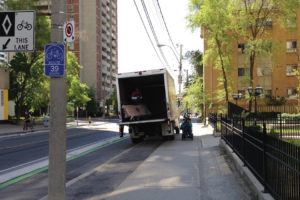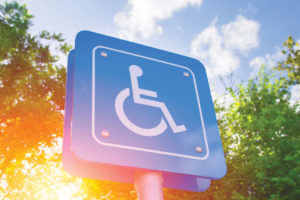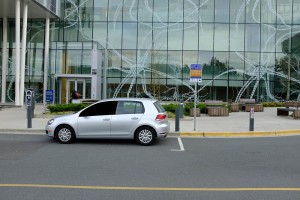By Peter Richards, IBI Group
Introduction
IBI Group worked with the City of Toronto on the Curbside Management Strategy. The City of Toronto has seen and continues to experience significant growth with substantial development adjacent to its right-of-way, resulting in considerable demands on the road network and excessive congestion; especially in the downtown core. Currently, curbside access (use of the shared space on a roadway adjacent to the sidewalk) is in high demand for motorists, cyclists, operators of transit, taxi, motor coach, courier and other deliveries/goods movement vehicles, and many other users.
The Curbside Management Strategy’s objective is to improve upon the efficiency and effectiveness of curbside space allocation and usage for all parking and loading activity, and to reduce congestion in the study area. The study area is bounded by Lake Shore Boulevard / Harbour Street, Bathurst Street, Queen Street, and Jarvis Street in Toronto. Between University Avenue and Yonge Street, the Study Area extends northerly to Dundas Street.
Activities under the Curbside Management Strategy (CMS) will help manage traffic congestion by:
- Using innovative solutions to improve the balance of safe access for people and goods with mobility;
- Reducing illegal parking which may affect traffic flow; and
- Increasing legal parking availability and reducing parking “search time” (i.e., cruising).
The CMS study involved the following overall tasks – reviewing of existing conditions, assessing future condition impacts, outreach and stakeholder engagement, reviewing best practices, developing strategies to evaluate, and recommending a set of policies and a proposed implementation plan.
Existing Conditions Review
The objective of the Existing Conditions review was to study the existing transportation conditions and curbside usage, issues, and opportunities in downtown Toronto within the proposed study area. This included a high-level review of existing City of Toronto policies and commitments, to ensure adherence and consistency for any potential recommendations. Some significant issues…
By Daniele Desjardins
In conjunction with the Canadian Parking Association’s Annual Conference and Trade Show, Parking, the Urban Mobility Perspective, Canada’s 1st Unified Mobility Leadership Summit will be held in Toronto from September 16 to 19, 2018.
The event comes as a result of the long-standing relationship between the Canadian Parking Association (CPA) and the Association for Commuter Transportation of Canada (ACT Canada), the only organization dedicated to sustainable mobility in Canada.
Moreover, the event epitomises the new mission statement adopted unanimously by the CPA Board of Directors at its strategy session held at the start of 2018: Connecting Parking and Mobility Professionals in Canada.
Both organizations’ annual meetings will be held simultaneously under one roof, where delegates are encouraged to take in the shared programming, to underscore the intertwined futures of parking and mobility, and help amplify the CPA’s conference theme.
In 2016, CPA and ACT Canada held concurrent events in Ottawa and shared some sessions and events that were of mutual interest. This year, the partnership between the two organizations has been purposefully strengthened and aligned so that programing is accessible to all delegates. The intent is to position parking as a key component of an overall unified mobility strategy and focus.
The CPA and ACT Canada relationship dates back to 2005, with CPA’s participation on ACT Canada’s National Advisory Team to help identify cross-sector issues that impacted integrated mobility across the country. Back then, a reciprocal agreement was established to formalize the relationship and set up goals to work together collaboratively and develop meaningful synergies, networks and information sharing.
“Since then, the commonalities between the two organizations have evolved not only inwardly, but as a collective undertaking across all transportation and mobility-related sectors. CPA hopes to lead the association market in adapting to new…
By Danielle Desjardins
Illegal parking is a major nuisance in urban environments. It leads to reduced traffic speeds, congestion, changes in travel modes, loss of revenue from valid parking spaces, decline in respect for the law and even to accidents1.
Illegally parked drivers run the risk of having their cars towed or, as it has been happening in private parking lots in some Canadian cities2, being clamped with a ‘Denver Boot’ and having to pay steep fines to recover the use of their car.
Parking psychology
So, what makes a driver decide he or she can park somewhere even though it’s forbidden?
Obviously, convenience and not having to pay must be powerful incentives, but let’s dig a little bit deeper into parking psychology. According to a study on the subject3, a driver’s behaviour is determined by a combination of four factors: attitude, intention, situation and habit.
A driver can have a well thought-out attitude towards a particular parking system, such as parking garages, or a particular parking garage, maybe based on safety preoccupations or location reasons. In some instances, situational factors (the weather, the traffic volume) that may influence a parking choice will intervene. Trip characteristics (destination, number and type of passengers) will also impact the decision-making process. Finally, some decisions are simply based on habits, a process more or less automatic that needs little attention in its execution, depending on the degree to which the decision is thought out, familiarity with the parking location, and convenience.
One of the main factors is likely to be travel goal. Whether our driver is travelling for business or personal reasons, such as an afternoon of shopping, price and proximity will be play a role. For the driver late for an important business meeting, proximity will be of the utmost importance and price, not so much. Conversely, the shopper…
By Patricia Kierans, MA Candidate in Critical Disability Studies, York University
We have all seen cars cruising around and around parking lots, looking for the ‘sweet spot’ parking space that will get them closest to their destination. And for accessible parking spots, this pressure is only magnified. The Ontario Building Code (OBC) only requires a minimum of one accessible parking space per every one hundred1. With the number of people with disabilities, and accessibility parking permits, increasing every year, how will parking lot owners rise to the challenge of increased demand for accessible parking?
The percentage of people with disabilities in Canada is increasing at a faster rate than the growth of the general population. Today, approximately 14% of Canadians have a disability that impacts their daily activities, with 80% of those report use of an accessibility aid2. In 2011, Human Resources and Skills Development Canada predicted the annual population growth from 2006 through 2036 would be ~1.3% per year, but the number of people with disabilities will increase by ~2.5% per year3.
The exact concentration of people with disabilities impacting mobility varies greatly across the country. People with disabilities, when possible, migrate toward urban areas seeking better access to specialized medical care, social services, and accessible public transit and buildings. Consequently, urban regions are predicting a major increase in the percentage of people with disabilities. The Peel Region of Ontario, including Brampton, has predicted a general population increase of 38% between 2001 and 2021, but an increase of 75% in the number of people with disabilities4.
While each province within Canada has differing requirements for the percentage of accessible parking spaces required for any parking facility, the ratio of accessible parking spots to regular spots remains extremely low. While all parking lots in Ontario adhere to the OBC’s minimum 1 space per…
Nothing is possible without the genius of the human being
INTRODUCTION:
Smart parking: the importance of the human factor
In a world where everything is becoming automated, where machines that make our daily life simpler become more and more intelligent and autonomous, interpersonal relationships are becoming a major asset in the employment market – for the good and simple reason that it is still very difficult for a computer to simulate human interaction.
After all, our ability to interact with our entourage is the result of thousands of years of human evolution. In the work place, these skills allow teams to combine their strengths and adapt to changing environments. They are at the heart of man’s advantage over machines.1
Where parking lot management is concerned, the latest technological advances can lead us to believe that these spaces, which are so indispensable for urban vitality, will no longer need humans to function effectively. Smart parking, smart car, smart city, everything is automated: cars drive themselves, a parking lot is found and is paid for remotely thanks to smart phone apps, and city streets are decluttered thanks to real-time signage that directs us toward available spaces.
However, these devices and smart equipment are still far from able to respond with a smile to the various very human questions and requests of users or even to indicate a secure route for money used in transactions, from its entry into the payment system to its deposit into the safes of the parking lot owner.
Parking, even if it is automated and becomes more and more “intelligent,” will still need humans for a long time yet in order to guarantee operational efficiency essential for individual mobility. Moreover, it is the perfect marriage between humans and technology that allows us to target the full potential of parking both today and tomorrow.
When it…
Municipal parking managers have the challenging task of balancing the management of a scarce resource and providing service to a wide range of customers. The mindset is a shift from the mentality of an enforcer to that of a protector.
Enforcement is the one element of parking planning and management that people generally don’t like to discuss. People resent getting parking tickets—or getting towed—and they often associate enforcement with greed on the parts of municipal parking authorities. Why else would a city penalize parkers with fines if they weren’t trying to generate additional revenues, right? (more…)
By Bill Smith
PHOTO CAPTION: Image shows car above a sensor within the stall and with the signage and meter. This is in front of the Centre for Brain Health (attached to and part of the Hospital)
Single space sensors are one of the most exciting parking technologies to be introduced in recent years. They have quickly gained acceptance throughout the industry because of the many benefits they offer both parkers and parking owners. The most obvious advantage can be found in their parking guidance function. By clearly and accurately indicating where open parking can be found, the sensor technology makes parking more convenient than ever before by eliminating the need for parkers to circle structures and lots looking for an open space. At the same time, the sensors collect data about who is parking in each space and for how long. This is invaluable information for helping owners and operators run their facilities as efficiently as possible.
The University of British Columbia (UBC) in Vancouver has found a new, non-traditional use for this technology. The University recently installed sensors in two areas on campus that have historically had trouble with drivers overstaying permitted parking durations. The areas are intended as drop-off points, but drivers tended to park for extended periods of time, which caused traffic congestion on nearby roadways. The sensors were installed to clearly indicate how long parking was permitted in each space, and encourage compliance with time limits.
UBC’s sensor program utilizes solar-powered Frogparking sensors, which are installed in the ground in each individual space and connected to the university’s parking management grid to provide real-time enforcement and utilization data. Nine sensors were installed at the UBC Hospital Complex and eleven were installed at the recreation center and aquatic centre.
“We began this program last August, and we are already seeing an…









